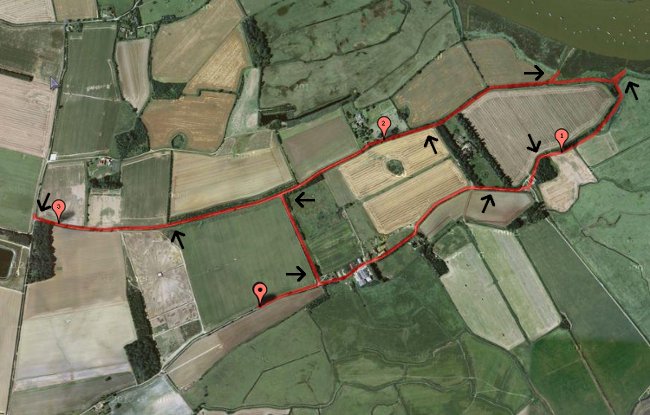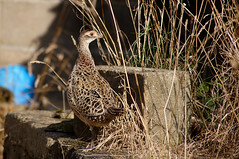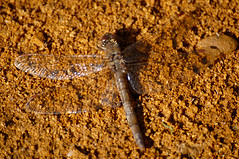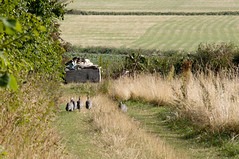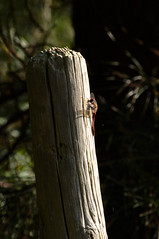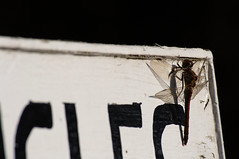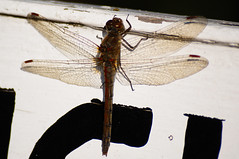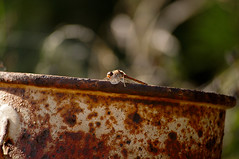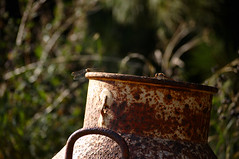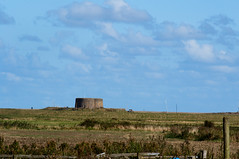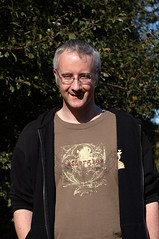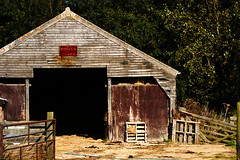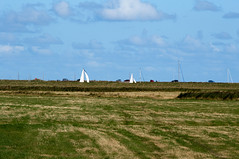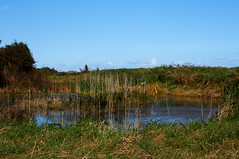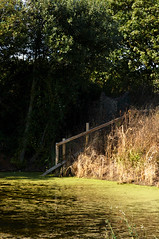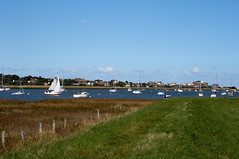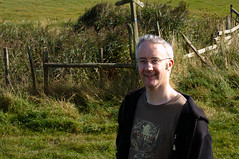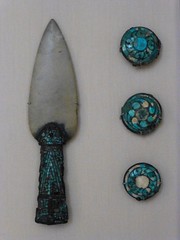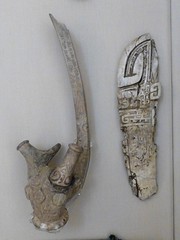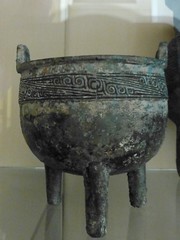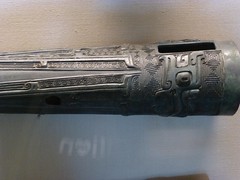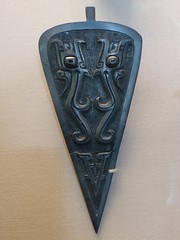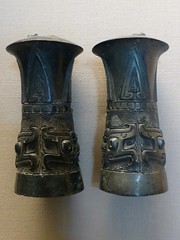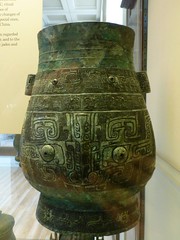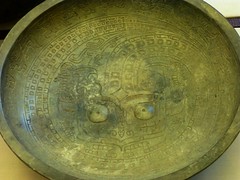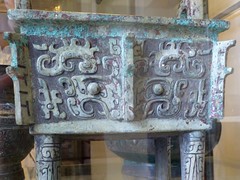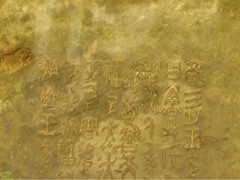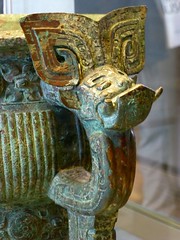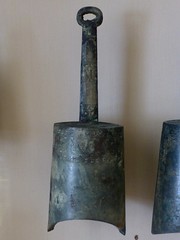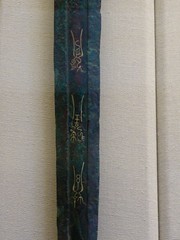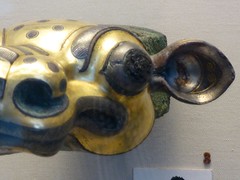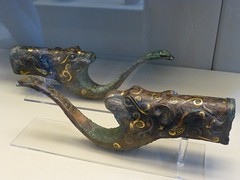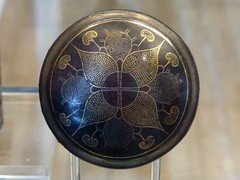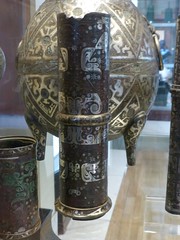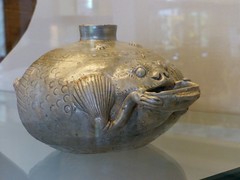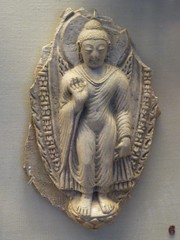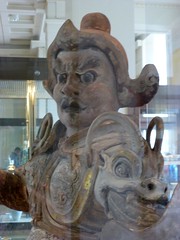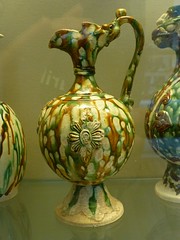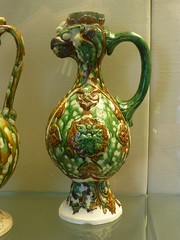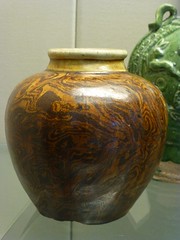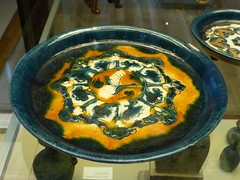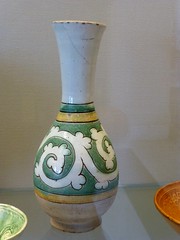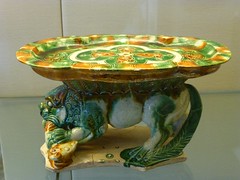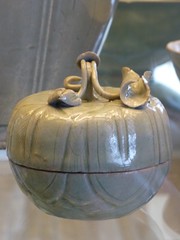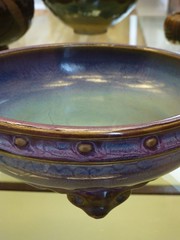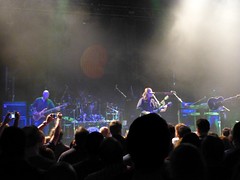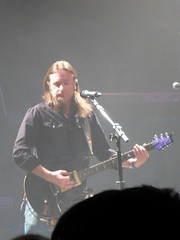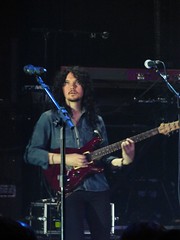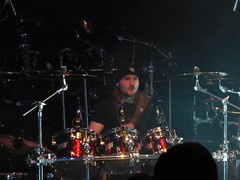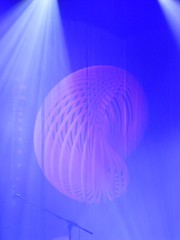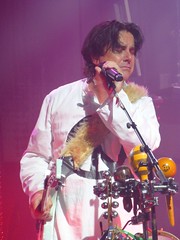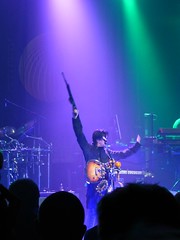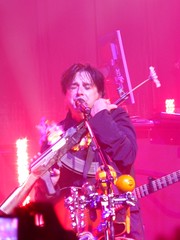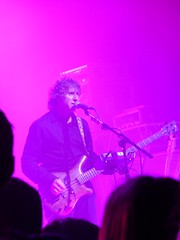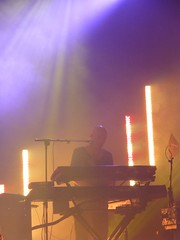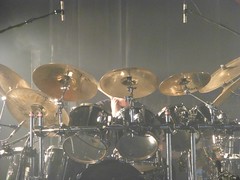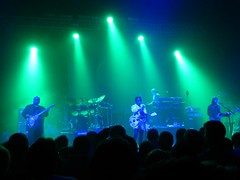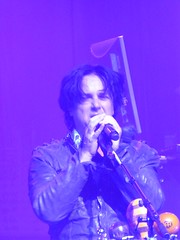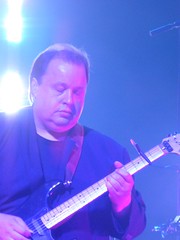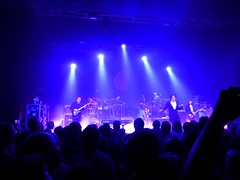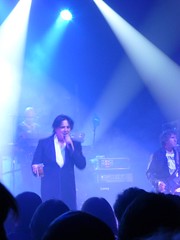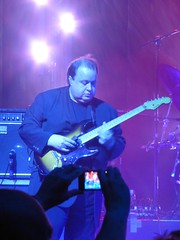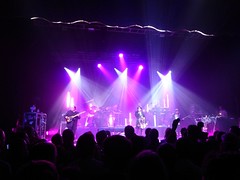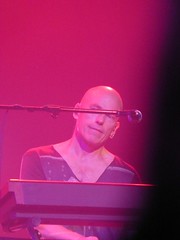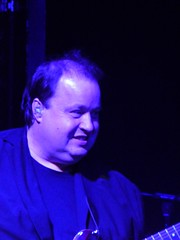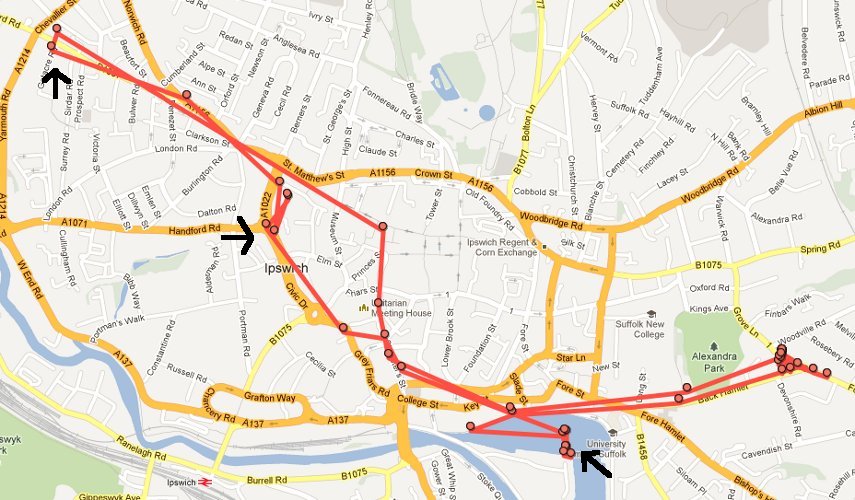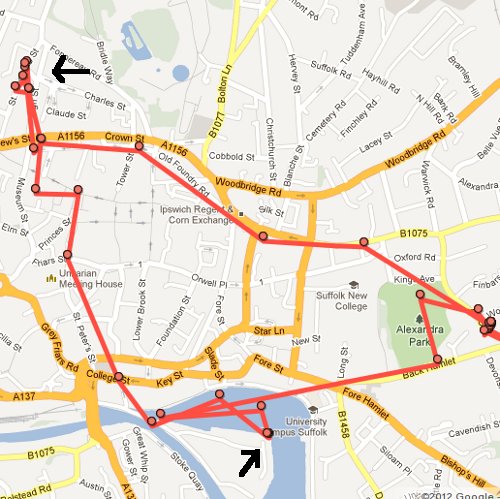The first TV night for a while, since we’ve been away or J’s been out or we’ve both been out on a Wednesday for several weeks. We started off with the last in the Britain’s Secret Treasures series that was broadcast on ITV a while ago. A technical niggle first – I don’t know if it’s our PVR or if it’s the channel itself, but the sound and images on ITV HD always seem just slightly out of sync. I noticed it during the World Cup and now with this series, it’s not a problem most of the time but with close-ups of people talking it’s a little disorienting.
The series was looking at the top 50 objects that have been found in recentish years by members of the public, chosen and ordered by Bettany Hughes and a panel of fellow experts. The programmes were presented primarily by Bettany Hughes & Michael Buerk … and I’m not entirely clear why Michael Buerk. He didn’t seem to’ve been involved in the choice or anything, effectively he was there to be a “pretty face” (or alternatively to provide an authoritative male figure for those who’d think Hughes too female to count?). Perhaps I’m over cynical here. Each object then had a short segment of film where some tenuously linked celebrity (like Michael Portillo looked at a Roman coin because it had an emperor on it and Portillo used to be the Defense Secretary so that’s all the same sort of thing – seriously, that’s what they said!) or an expert in the subject went off to the site it was found, and/or somewhere relevant, and told us about the object and why it was significant, and maybe interviewed some experts on the subject.
The best thing about the series was the chance to see all these lovely things, and to hear the stories about the lucky finds. And in general I thought the objects were well chosen – I don’t know if they’d be my top 50, not only am I not an expert but I don’t know what the choice was from, but I thought they were a good top 50 if that makes sense. And I don’t regret watching the programmes.
But – and you could tell there was a “but” coming, couldn’t you? But I think there were some odd choices in the presentation of the series. By necessity it was a shallow look at the objects, but some choices of what to dwell on and what to gloss over were odd. The one that sticks particularly in my mind is the programme where we had a 5 minute segment of Hughes scuba diving in a river looking for coins (the objects this was related to had been covered earlier for 5 minutes already), and there was at least one object in that programme that got about 2 sentences & moved away from. Personally I’d’ve skipped the diving and looked at the actual objects more. There were also some odd choices of experts – particularly this last programme where both J and I were spluttering over the choice of a priest to talk about a 4000 year old gold cup. Yes, it was found in what was probably a temple, but I don’t think a spiritual leader of Christianity has any special insight into possible religious practices of people who lived in Britain around 2000BC, and leaping from how the rituals around the chalice in Christianity are about both communion with God and communion with the community to how this cup must’ve also been part of a communion ritual seemed like a very good example of bringing one’s own cultural blinkers along. (I’m not saying it’s not true, I don’t actually know anything about the subject, but I am saying I thought it was a poor argument.)
So in summary, good to have seen but at times eye-rolling to listen to.
Our second programme of the evening was the first episode of Neil Oliver’s new series, Vikings. This is actually only timeshifted by a little over a week, quite prompt for us!
I’ll start with the negative, and get it out of the way – I don’t like the stylistic choices of the director and/or cameraperson for this and the other recent Neil Oliver serieses (the one about the Bronze Age and before & the one about the Iron Age, I can’t remember what they were called). Basically they make me notice the camera too much, my preference for a documentary is for it not to try too hard to be “arty”. They do stuff like when they’re showing you an object they have a narrow depth of field and shift the focal plane around – and I just want to see the whole thing, damnit. Also shaky cam while he’s walking along talking to the camera, which I think is supposed to make it feel intimate but just reminds me there’s a cameraperson there. Having said that – both of those were toned down from the previous serieses. They’d added a new trick though, shots that made everything look minature – street shots where it looked like little mobile dolls walking between dolls houses. Which I found deeply deeply creepy in a visceral fashion.
However, that’s enough bitching about the filming. The programme itself was interesting, and it promises to be an enjoyable series. The premise is to look at the Vikings from the Viking point of view & this first programme was setting the scene. First we had a brief section reminding us of the things “we all know” about Vikings, just to get us all on the same page at the start. So he spent a little bit of time in York with a few wee toy models of Vikings and some kids dressed up with helmets & swords playfighting, pointing out that most of this is later myth. And then we were off to Scandinavia to look at both the land the Vikings came from, and their history before the first raids on Europe.
The land obviously shapes the society that lives in it – and particularly in the far north of Scandinavia, like Norway, there isn’t much arable land. Clearly over time this leads to population pressure, so a culture of young men going out adventuring would ease this both by killing some of them off and by having them bring back wealth from other more fertile regions. This and the amount of coast also makes seafaring important – during the sort of time period that Stonehenge was built, the people on Gotland were building stone ship shapes. An integral part of their culture even in the Bronze Age.
He also made the point that Scandinavia was never part of the Roman Empire, and this shaped the people & culture by not shaping them. The Scandinavians kept their old gods, rather than being integrated into Roman religion and then later into Christianity. And their gods and religion emphasised that while you will inevitably die your reputation will live forever. I wish I could remember the exact words – there was a segment of the programme where he talked to a scholar who was an expert on the old religion & she read out some of what I think was an Old Norse book about it, and translated it into English for us. It was much more poetic than how I phrased it. And what mattered to a Viking about his reputation was that he wasn’t a coward – honour and glory were what would keep your memory alive.
As well as keeping their own religion they also weren’t urbanised by the Romans – so while the south of Scandinavia (Denmark) had wealthy individuals and even regional kings, they weren’t organised in towns. I think the point here was that this is a contrast to the way that the ex-Roman Empire parts of Europe thought that a society was automatically organised. As part of this section he also showed us objects that demonstrated that the southern Vikings at least did have trade connections to quite far afield. Some very impressive silver cups which I think were from the Mediterranean and were decorated in a Roman style with scenes from the Iliad. Also the bones of two women from a ship burial just before the time of the first Viking raids on Britain – and one of these women DNA analysis has shown that she may’ve had some connection to Middle Eastern peoples. (I was unclear if he meant that she herself was from the Middle East or if she had ancestors from the Middle East, perhaps because that’s not actually known.)
So that was a fairly brisk sweep through a vast swathe of history & geography to give us a flavour of where the Vikings came from both culturally & physically. Next I guess we’re on to what the Vikings actually did 🙂
Marillion did a (fairly short) UK tour just after the new album came out and we went to the show in London on 16th Sept. We did a bit of museuming beforehand (which I’ll write up another time), then met Ady & Pete at Kentish Town to find dinner before the show. Paul was supposed to join us too, but his trains were all screwed up so he had to give it a miss 🙁 Ended up eating in Nandos, which I haven’t done in probably a decade … and it would’ve been that Nandos last time too, before a Marillion gig!
Unusually I had a camera with me, a few years ago most concerts tried to stop you taking photos but things have moved on a bit. Didn’t take the big camera, obviously, if nothing else it’s awfully hard to take photos at arms length above my head with that one. And despite taking quite a lot of photos (coz only a few would come out) I didn’t watch the whole show through the viewfinder either 😉 All the pics are on flickr, so click through for a larger version.
The support band for the evening were DeeExpus – Mark Kelly (keyboards in Marillion) plays on the album, but didn’t come out and play on stage with them. We do actually have the album, but I haven’t listened to it much so I didn’t know the songs. They sounded good at the time, but haven’t really stuck in my head at all.
And then on to the main act! They started with a little fake-out of the intro to Splintering Heart, followed by explosions and then into Gaza – the opening track off the new album (which is called “Sounds That Can’t Be Made”). A bit of a politically charged song, as it’s about the humanitarian side of the situation in Gaza, and it made for a powerful start to the show.
I think I’ve said before I’m bad at remembering setlists. As well as four songs off the new album, this one had some old classics like This Town and Great Escape, some of the newer classics like Neverland and You’re Gone. Oh and a rendition of A Few Words for the Dead where h waved a gun around, with a flower in it for the bit where the lyrics kick in with “or you could love”.
The (last) encore was Sugar Mice which is a favourite of mine (starting with a slightly ropey crowd sing-along), and in a nice touch the final song – Estonia – was dedicated to Neil Armstrong. The show was recorded, and they’d organised it so that you could buy the CD after the show, which was kinda neat 🙂
We’ve been to find a few caches in Ipswich since coming back from Northumberland, but with a lower success rate. The first trip in Ipswich was a complete failure – we were only looking for one cache, which is in the park near our house. Unfortunately when we got to the rough area of the site we discovered it’s completely overgrown with nettles, and despite J’s best efforts at looking we had no luck at all. J got very stung by the nettles, tho 🙁 (I had a skirt on & bare legs, so didn’t venture into the nettles at all!)
However our next trip was better.
Day 5
We met up with some of J’s work colleagues (Kerry, Peter, Anna & Adam), near the College, and headed off to find some caches. All three we were looking for were puzzle ones – you have to solve the puzzle on the website to get the actual co-ordinates of the cache (it does give you wrong-but-close co-ordinates to get you to the vague vicinity). I’d not actually done any of the solving myself (to be honest with the geocaching stuff I’m pretty much just along for the ride, it’s a good excuse for a walk and to be sociable). The first one we were looking for was “Ipswich Haven Marina” and we failed with that one 🙁 Peter had been a couple of times before & failed to find it, too. The cache owner got in touch with J and with Kerry after they logged DNFs, so we now know that we do have the right co-ords and that the cache is still there (he checked for us). So another trip another day! (Peter has already gone back and found it, so it’s definitely definitely there 😉 )
The next two were successful! One near the New Wolsey Theatre (“What a Performance”) and one a little way up Bramford Road (“A Cachers Melody”). Both found without much trouble, despite it being dark by the time we got to them.
And after that we headed back into town to get some food, ending up at the Kwan Thai partly by virtue of it still being open at 9:30pm. And partly because it’s a nice resturant 🙂
Day 6
J and I went back out on Saturday afternoon, and promptly discovered the “Ipswich Haven Marina” cache – not quite sure how we all missed it before, to be honest.
We then (via a coffee in Cafe Nero) headed off to look for “A hard one …” which J and Anna had solved the puzzle for the day before. We searched for quite a while, but in the end had to admit defeat on that one 🙁 We did check the co-ordinates with the cache owner once we got home & apparently we’re right so perhaps it’s vanished or perhaps we just need to look harder!
Back in January there was a five part series on the Written Word as part of the In Our Time series, which is what we’ve chosen to listen to next. This is a slightly different format in that instead of 3 guests in the studio Bragg is going to museums etc & talking to the curators & experts there.
This programme covered the initial development both of writing itself, and of the alphabetic system we use today. He went and looked at (and described to us) examples of early cuneiform writing, Egyptian hieroglyphs and Chinese oracle bones, which are three of the four independent inventions of writing. It’s interesting that something so fundamental to modern civilisation was invented so few times – as well as the three I listed there’s also an independent development on the American continent, but all other writing systems were developed from other systems or directly inspired by other systems.
(It’s actually a little controversial to say that Egyptian writing was developed independently like I did in the preceding paragraph – it may’ve been inspired by cuneiform, however the earliest known Egyptian writing is getting to be early enough that it’s more likely to be independent. Also J’s been reading a book about the development of writing, and it also makes the point that the Egyptian and Mesopotamian writing systems developed for different reasons – Mesopotamian writing was proto-book keeping, Egyptian writing had religious significance. So probably independent origin.)
I actually found the Chinese stuff the most interesting as it was completely new to me – in ancient China (in the Shang Dynasty) the rulers read oracles in the pattern of cracks that you get by using a hot poker on ox shoulder bones. These oracles were then recorded on the bones by scribes in the earliest known forms of modern Chinese characters, which makes the Chinese system the longest consecutively used modern writing system.
The programme also name checked Linear A (undeciphered) and Linear B (a syllabic system that was an early way to write Greek), and then moved on to the development of our more familiar alphabet. It made the point that the Greek alphabet was the first to write down vowels – previous alphabetic systems were for Semitic languages and due to the way those languages are structured the consonant sequences are less ambiguous (as I understand it). So to a native speaker it’s a lot more obvious in context what a word is than it would be in English (or presumably Greek).
